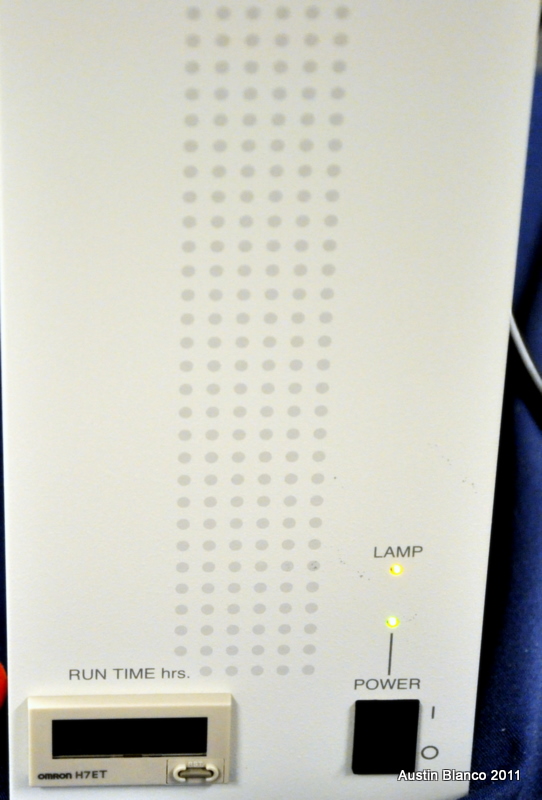
Overview
Over the past 12 months, several new LED driven light engines have been released to market. I’ve posted on a few of these systems a while back. The big question here, more than anything else, is how much light do these boxes actually deliver to the scope? More importantly, my colleagues and I wanted to know the truth, i.e. how do these new light engines stack up against the current standards? The problem is that it seems each light source manufacturer claims that they have the most powerful source. This obviously cannot be correct, so what IS the truth? Are light engines as powerful as conventional sources? The only way to find out would be to test all of the sources on a static setup, so we did.
***Most of these tests were performed by Aaron Lum Ph.D, from Technical Instruments, without his work this review could not have been completed. Thanks Aaron for your hard work in administering and executing this project!
First, we collected an array of the newest instruments available. The systems tested were:
- Nikon Intensilight (Baseline)
- 89 North Heliophor
- 89 North Photofluor
- Lumencor Spectra X
- Lumencor Sola
The Intensilight represents the typical metal halide source in use today. Many systems, including the Exfo Excite, which is the most widespread source, rely on this metal halide lamp to produce similar peaks to that of mercury, but with the advantages of a much longer life and no need for constant realignment. While the Photofluor also falls into the metal halide category, we tested it uniquely because of it’s high power and light stability claims. One system we really want to test, but couldn’t get our hands on, is the Sutter Instruments Lambda XL. This system has enough power to explode conventional soft-coated filters. Obviously my MORE POWER! interests are motivation to test this unit. Alas, all of Sutter’s demo systems were committed to a training at Woods Hole, so we were unable to tests this system.
Testing
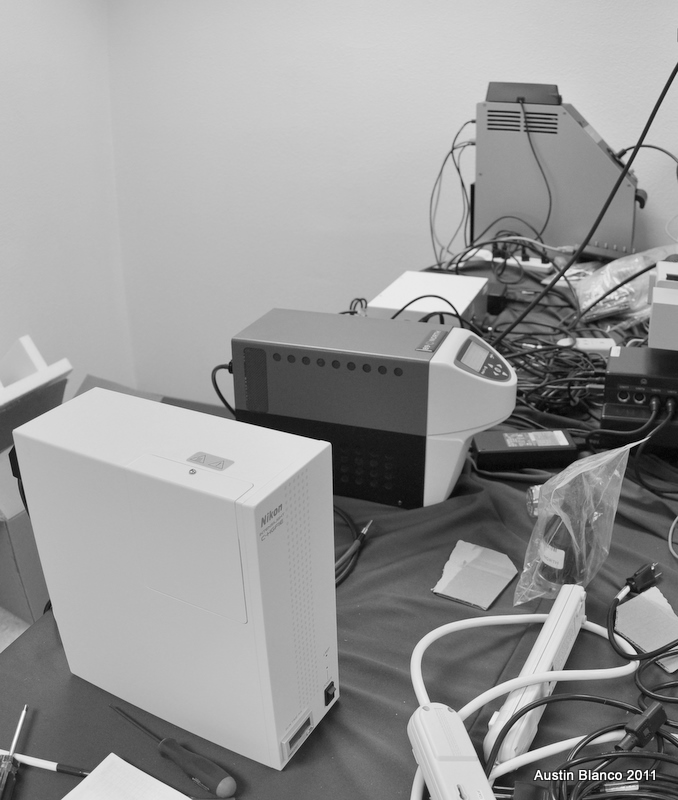
Our tests used the following system configuration. We are aware of several known errors in the test, but we resolved that no tests would be without error, and the goal here was to get a big-picture comparison.
- Testing was performed on an inverted Ti-E microscope, using a 10x Plan Fluor CFI 60 Lens.
- The microscope included a Tirf/Epi attachment, but the system was placed in Epi mode for the duration of the tests.
- Each light source was tested with it’s provided liquid light guide and coupler. When no coupler was provided we used the standard Nikon Intensilight coupler.
- Fluorescent cubes used were Chroma part #’s 49021 (DAPI), 49002 (GFP), 49011 (FITC), 49005 (DsRed) and 49008 (mCherry/TxRed)
- Chroma Fluorescent test slides in Blue, Green and Red (plastic, monochrome in color) were used at the appropriate cube combinations (i.e. Blue for DAPI, Green for GFP & FITC, Red for mCherry and DsRed).
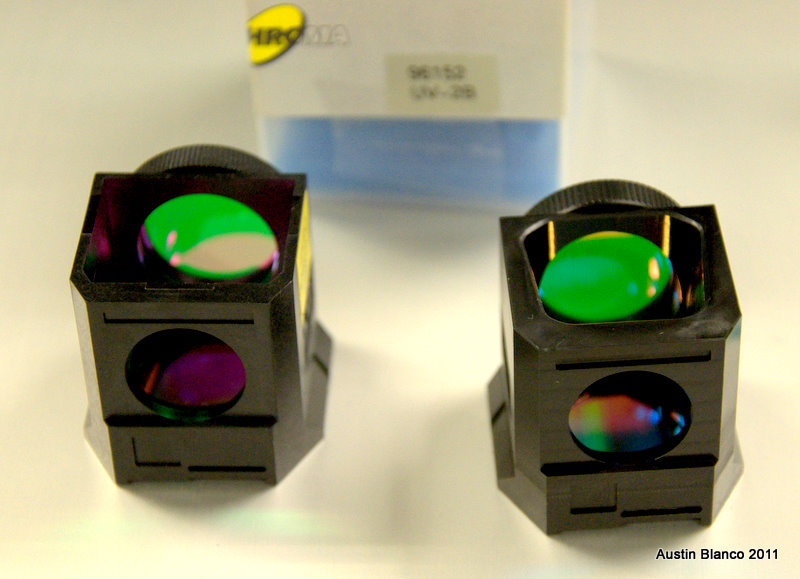
We investigated the options of using a spectrometer, a laser power meter, or some other external measuring device to compare power, but we settled on using a camera. The reasons being the camera was more than linear enough, consistently sensitive, had a known spectral deviation in it’s QE, which was consistent (and which we could therefore ignore) and readily available. The other benefit to using a camera is that everyone involved in the testing is extremely familiar with camera operation, vs. other, new instruments where the opportunity for user-induced error is greater. The test procedure was as follows:
- One of the light sources was connected
- The same focus value was used, determined by focusing on a test slide of appropriate color for the cube used in transmitted light
- A filter cube was selected
- The camera was set to “autoexpose” in several cycles. The autoexposure time in mS was recorded
- Steps 3 and 4 were repeated for all cubes, then a new light source was selected and tested
Potential sources of error
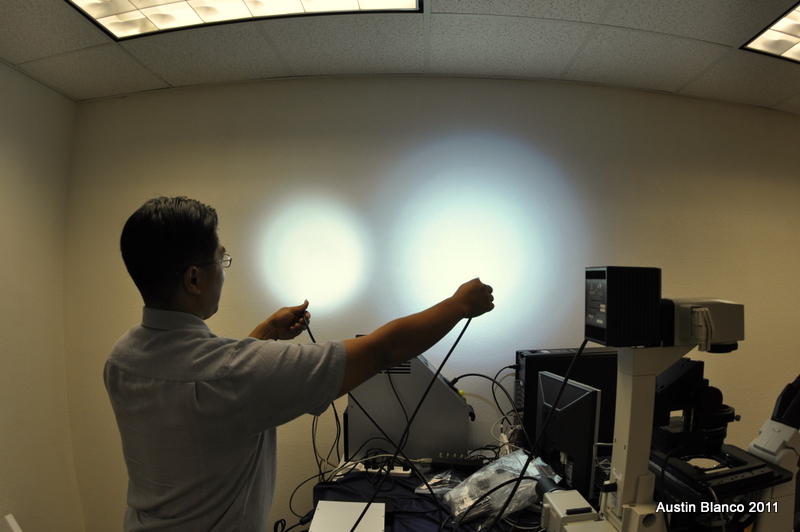
We have identified the following items that likely impacted the measured results:
- The liquid light guides, lengths and diameters were used as provided by the manufacturers. These different aspects can have a significant impact in the evenness and total power of the light.
- For the systems that are spectral-specific, it is important to note that the filter cubes used had excitation filters in them thus the spectral-specific sources were double-filtered.
- The cubes used were generic, and employing the best suited cubes for each light source would impact the overall performance, to an unknown degree.
Results
To graph the results, we segmented the systems into two groups, white-light illuminators and spectral-specific illuminators. Spectral-Specific illuminators like the Spectra-X and Heliophor are wavelength-selectable. These units in some cases don’t need any additional spectral filtering to be performed on the excitation side of the microscope. This can be a nice advantage over white-light illuminators, as spectral-specific units don’t require a filter wheel to be purchased or employed on the microscope. One downside to these systems is that the overall power they emit is lower than that of a white-light system, simply due to the overlap of source spectra in the light engines. This can be seen by the increased exposure time for these systems in the results below. Some additional notes on the testing:
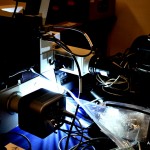
- ALL exposure times seen here are using an 8ND filter, i.e. the exposures would be 1/8 of those seen here.
- Due to the above, any of these systems would be perfectly useable for live cell imaging.
- The spectral-specific systems are at a major disadvantage here as they are pre-filtered, vs. white light, causing the overall intensity to be lower than would be used in an optimized system.
All systems as measured:
Obviously the spectral specific sources have the longest exposure times, and are therefore not as bright as the Sola, or the conventional sources. If we eliminate these two spectral-specific systems we see the following:
What I find interesting here is not that in the UV, the Sola isn’t as bright. This is to be expected, as LED-based engines can’t produce the deep UV that can currently be obtained using arc lamps. The surprising part is that the the Sola and the Photofluor match one another in the reds. The Sola also does a great job in the greens. Keeping in mind the extremely small deviations here, it is arguable that the Sola could be used as a “white light” replacement for conventional systems, assuming you don’t need extremely bright UV excitation. This is a major milestone for LED based light engines.
Below is a chart showing the exposure times between the Heliophor and the Spectra X:
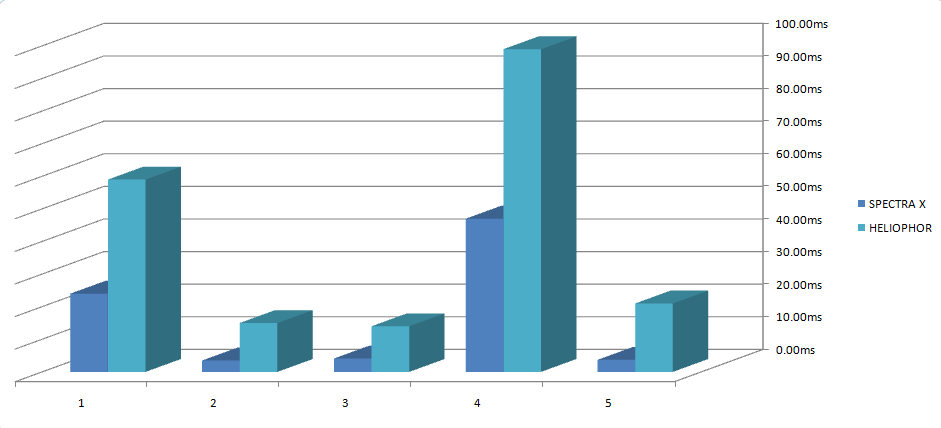
My Conclusions
After working with these systems for a few days and reviewing the data, I find some surprising things to note:
- It’s not until you use an LED engine that you appreciate the lack of heat, and noisy cooling fans. I know this is a rather small thing, but as they say, silence is golden.
- There is an interesting tradeoff between the Heliophor and the Spectra X. The Spectra X offers greater power, but the Heliophor offers a highly regulated linear output.
- The Sola competes effectively with conventional sources in overall power.
- The non-conventional systems don’t require shutters, as such there is no vibration, or significant lifetime limitation, for shutters. Simply power down the LED drivers.
- The conventional systems were tested with new bulbs. Most people aren’t aware of this, but arc lamps typically lose 50% power over the first half of their lifetime! LED driven light engines don’t have this problem.
Example Applications
With the addition of these new systems I will change my product recommendations to customers as follows:
- If you need UV for uncaging, activation etc. stick with a conventional light source
- If you want a general-use system I’d seriously consider any of the LED light engine systems
- If you have specific vibration requirements and/or longevity requirements I would seriously consider a spectral-specific light engine
- If your work requires highly linear excitation light, the Heliophor should be seriously considered for it’s accurate modulation of power over time.
I’d also like to thank Carey Camacho, our service department guru and accomplished slack-key guitarist, for lending us his prized camera, and to the companies involved, for allowing us to test these products.
– Austin
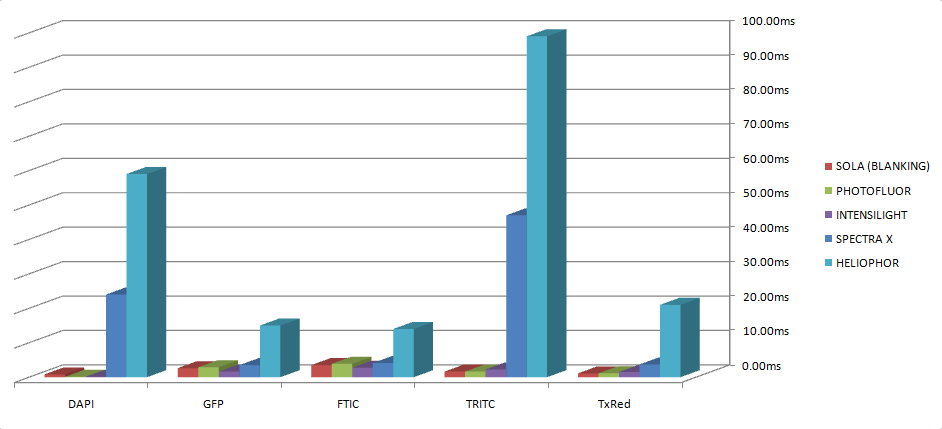
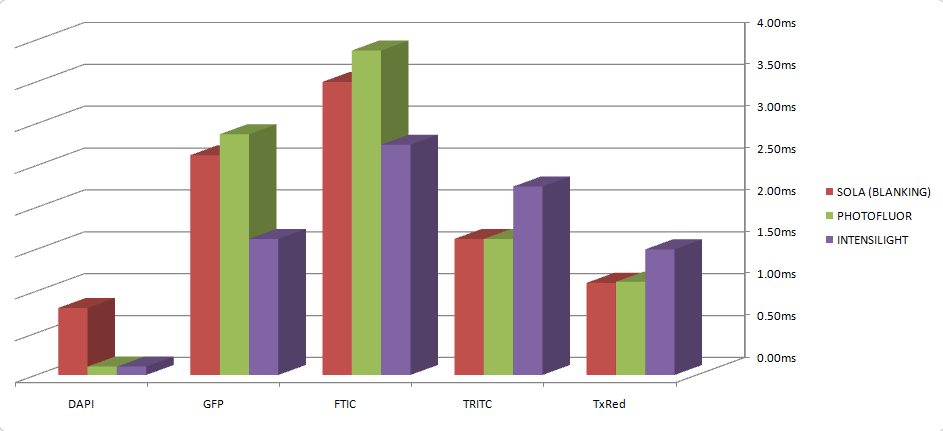
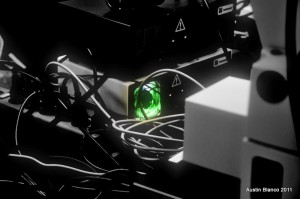
Comments
5 responses to “Light Source Shootout: Intensilight, Photofluor, Spectra, Heliophor and Sola”
One of the greatest benefits within the LED market may not be power, but rather a precise match to the excitation spectrum of the target. High power, though it can shorten exposure times, can also cause damage to sample and equipment.
Similarly, when attempting to study affects outside of the impact of light, less power and longer exposure times (in a carefully balanced equation) can provide more natural cellular response to imaging. This can “help” iscolate whatever veriable you may be studying.
I have done similar research, and I would like to add, it is not easy!! Comparing light sources is a far more difficult task then you gentlemen let on! Great work here! I have more than a few labs I will be referencing these findings too!
CM
Cool. I’ve been looking forward to LED illumination for some time.
We just bought an Intensilight for our new scope. But I was wavering between that and the Lambda XL. I’ll be interested to see test results between those two someday.
Nice review 😉
You need to take great care to match the dichroic and filter combination with the LED line. I think that this was done, but want to be sure; I find this the best LED evaluation that I have seen so far!!
How are the LED’s coupled from the illuminator body to the WF/TIRF arm?
Did you look at something real like acton fiber? Evaluations based on intensity are one thing… how do they compare in a biological sample?
We had wanted to test the Sutter XL and LS as well but the timing didn’t work out with Sutter’s demo equipment (it’s my fault because I didn’t give them enough lead time). Initially, we weren’t going to go through as much testing as we did but just figured it would be worth the time once I started getting some of this equipment together. Part II of this probably won’t come until August or September because of personnel and equipment availabilty…
Glad you are finding this helpful